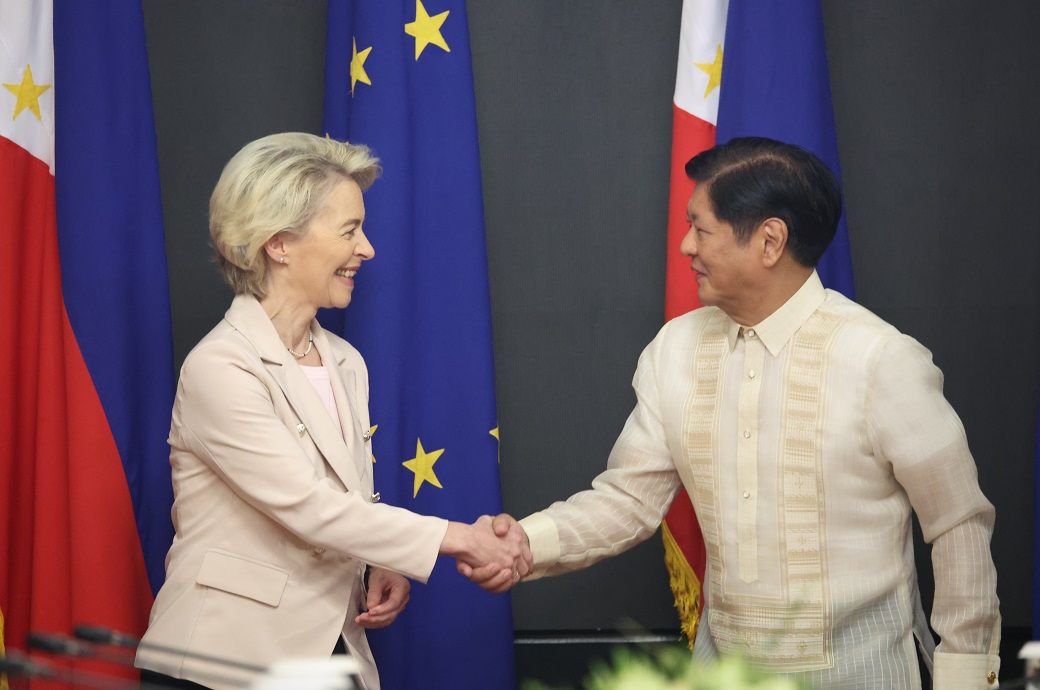EU & Philippines take steps towards FTA, emphasising sustainability
EU & Philippines take steps towards FTA, emphasising sustainability Fibre2fashion.com


The European Union and the Philippines to Explore Resumption of Free Trade Agreement

The European Union (EU) and the Philippines have announced their joint intention to explore the resumption of negotiations for a modern and balanced free trade agreement (FTA), with an emphasis on sustainability. This bilateral ‘scoping process’ is designed to assess the shared understanding on the prospective FTA. If successful, the EU and the Philippines could soon resume FTA negotiations.
Importance of Sustainable Development Goals (SDGs)
Ursula von der Leyen, Commission president, highlighted the importance of the Philippines as a key partner in the Indo-Pacific region and expressed optimism about elevating the partnership to the next level. “Together, we will realise the full potential of our relationship, creating new opportunities for our companies and consumers while also supporting the green transition and fostering a just economy,” she said.
Strategic Significance of the Indo-Pacific Region
This announcement follows the recent resumption of FTA talks with Thailand and affirms the strategic significance of the Indo-Pacific region for the EU’s trade agenda. The aim is to forge deeper trade connections with the vibrant South-East Asian economy and reinforce the EU’s alignment with this expanding region, the European Commission said in a media release.
Goals for the Free Trade Agreement
The EU’s goals for the FTA with the Philippines encompass ambitious market access commitments, effective sanitary and phyto-sanitary procedures, intellectual property rights protection, and robust disciplines on Trade and Sustainable Development (TSD), aligned with the Commission’s TSD review Communication of June 2022. Sustainability will be central to this agreement, emphasising high standards for workers’ rights, environmental protection, and ambitious climate goals.
Trade and Investment Figures
Trade between the EU and the Philippines was valued at over €18.4 billion in goods in the past year, positioning the EU as the Philippines’ 4th largest trade partner. Moreover, the EU is one of the largest investors in the Philippines, with foreign direct investment stock reaching €13.7 billion in 2021.
Under the EU’s Generalised Scheme of Preferences + (GSP+), the Philippines enjoys special incentives and duty-free access to the EU market for two-thirds of tariff lines. Continued access depends on adherence to international conventions on human rights, good governance, and environmental protection.
Resumption of FTA Negotiations
FTA negotiations between the EU and the Philippines commenced in 2015 but have been stalled since 2017. The new administration, which took office on June 30, 2022, has expressed readiness to engage with the EU on crucial issues.
This development aligns with the 2021 EU Indo-Pacific Strategy, confirming the EU’s interest in resuming FTA negotiations with the Philippines. Alongside existing FTAs with Singapore and Vietnam, ongoing talks with Indonesia, Thailand, and a scoping exercise with Malaysia, this step further solidifies the EU’s commitment to strengthening trade ties with the ASEAN region.
Team Europe Initiative on Green Economy
In a significant move towards a sustainable future, von der Leyen and President Ferdinand Marcos have also launched the Team Europe Initiative on Green Economy under Global Gateway. The initiative is backed by a Team Europe contribution of €466 million.
Objective of the Initiative
The Team Europe Initiative on Green Economy aims to formulate an industry-led alternative to the prevailing plastic waste management system. The project seeks to build sustainable plastic value chains and minimize plastic waste and marine litter.
Fibre2Fashion News Desk (KD)
SDGs, Targets, and Indicators Analysis
1. Which SDGs are addressed or connected to the issues highlighted in the article?
- SDG 8: Decent Work and Economic Growth
- SDG 9: Industry, Innovation, and Infrastructure
- SDG 12: Responsible Consumption and Production
- SDG 13: Climate Action
- SDG 17: Partnerships for the Goals
The article discusses the intention of the European Union (EU) and the Philippines to explore the resumption of negotiations for a free trade agreement (FTA) with an emphasis on sustainability. This aligns with SDG 8, which aims to promote sustained, inclusive, and sustainable economic growth, full and productive employment, and decent work for all. It also connects to SDG 9, which focuses on building resilient infrastructure, promoting inclusive and sustainable industrialization, and fostering innovation. The emphasis on sustainability in the FTA negotiations relates to SDG 12, which aims to ensure sustainable consumption and production patterns. Additionally, the article mentions the goal of supporting the green transition and ambitious climate goals, which aligns with SDG 13 on climate action. Finally, the partnership between the EU and the Philippines reflects SDG 17, which emphasizes the importance of partnerships for achieving the Sustainable Development Goals.
2. What specific targets under those SDGs can be identified based on the article’s content?
- Target 8.5: By 2030, achieve full and productive employment and decent work for all women and men, including for young people and persons with disabilities.
- Target 9.1: Develop quality, reliable, sustainable, and resilient infrastructure, including regional and transborder infrastructure, to support economic development and human well-being, with a focus on affordable and equitable access for all.
- Target 12.2: By 2030, achieve the sustainable management and efficient use of natural resources.
- Target 13.2: Integrate climate change measures into national policies, strategies, and planning.
- Target 17.16: Enhance the global partnership for sustainable development, complemented by multi-stakeholder partnerships that mobilize and share knowledge, expertise, technology, and financial resources.
Based on the article’s content, the specific targets under the identified SDGs can be inferred. The intention to explore a free trade agreement that promotes sustainability aligns with Target 8.5 of SDG 8. The emphasis on sustainability in the FTA negotiations relates to Target 9.1 of SDG 9. The goal of achieving sustainable consumption and production patterns is connected to Target 12.2 of SDG 12. The commitment to ambitious climate goals reflects Target 13.2 of SDG 13. Finally, the partnership between the EU and the Philippines demonstrates progress towards Target 17.16 of SDG 17.
3. Are there any indicators mentioned or implied in the article that can be used to measure progress towards the identified targets?
- Indicator 8.5.1: Average hourly earnings of female and male employees, by occupation, age group, and persons with disabilities.
- Indicator 9.1.1: Proportion of the rural population who live within two kilometers of an all-season road.
- Indicator 12.2.1: Material footprint, material footprint per capita, and material footprint per GDP.
- Indicator 13.2.1: Number of countries that have communicated the establishment or operationalization of an integrated policy/strategy/plan which increases their ability to adapt to the adverse impacts of climate change, and foster climate resilience and low greenhouse gas emissions development in a manner that does not threaten food production.
- Indicator 17.16.1: Number of countries reporting progress in multi-stakeholder development effectiveness monitoring frameworks that support the achievement of the Sustainable Development Goals.
The article does not explicitly mention specific indicators. However, based on the identified targets, indicators can be inferred. For Target 8.5 of SDG 8, the average hourly earnings of female and male employees, by occupation, age group, and persons with disabilities (Indicator 8.5.1) can be used to measure progress. Indicator 9.1.1, which measures the proportion of the rural population who live within two kilometers of an all-season road, can be used to assess progress towards Target 9.1 of SDG 9. Indicator 12.2.1, which measures the material footprint, material footprint per capita, and material footprint per GDP, can be used to track progress towards Target 12.2 of SDG 12. The establishment or operationalization of an integrated policy/strategy/plan to adapt to climate change and foster climate resilience (Indicator 13.2.1) can be used to measure progress towards Target 13.2 of SDG 13. Finally, Indicator 17.16.1, which measures the number of countries reporting progress in multi-stakeholder development effectiveness monitoring frameworks, can be used to assess progress towards Target 17.16 of SDG 17.
4. Table: SDGs, Targets, and Indicators
| SDGs | Targets | Indicators |
|---|---|---|
| SDG 8: Decent Work and Economic Growth | Target 8.5: By 2030, achieve full and productive employment and decent work for all women and men, including for young people and persons with disabilities. | Indicator 8.5.1: Average hourly earnings of female and male employees, by occupation, age group, and persons with disabilities. |
| SDG 9: Industry, Innovation, and Infrastructure | Target 9.1: Develop quality, reliable, sustainable, and resilient infrastructure, including regional and transborder infrastructure, to support economic development and human well-being, with a focus on affordable and equitable access for all. | Indicator 9.1.1: Proportion of the rural population who live within two kilometers of an all-season road. |
| SDG 12: Responsible Consumption and Production | Target 12.2: By 2030, achieve the sustainable management and efficient use of natural resources. | Indicator 12.2.1: Material footprint, material footprint per capita, and material footprint per GDP. |
| SDG 13: Climate Action
Behold! This splendid article springs forth from the wellspring of knowledge, shaped by a wondrous proprietary AI technology that delved into a vast ocean of data, illuminating the path towards the Sustainable Development Goals. Remember that all rights are reserved by SDG Investors LLC, empowering us to champion progress together. Source: fibre2fashion.com
Join us, as fellow seekers of change, on a transformative journey at https://sdgtalks.ai/welcome, where you can become a member and actively contribute to shaping a brighter future.
|








